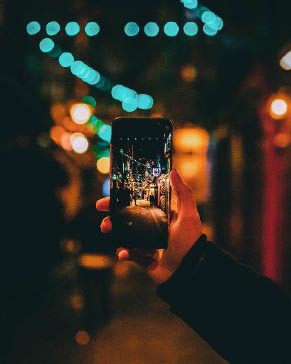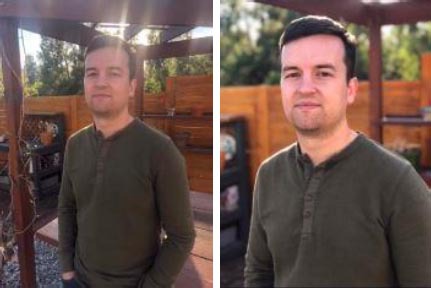MOBILE PHOTOGRAPHY
Smartphone photography has come a long way since they were invented. There is no faster way to take a photo and share it than from the same device you use to view social media. In today’s smartphones, we see a wide range of really advanced sensors, lenses and in some cases portrait mode and settings that mimic the shallow depth of field of more expensive cameras. When you combine the advancement in some of these phone cameras, the post apps on them and the ability to share instantly, the camera phone is a force to be reckoned with, when comparing them to other cameras. New to a lot of phones is the portrait mode. Your phone is able to distinguish between subject and background creating that shallow depth of field look. It does that by using the wide lens and the telephoto lens and blurring the background in the processing. Smartphone photography is always changing an endless.
USING A SMARTPHONE CAMERA
Every smartphone is different. The first thing you have to understand about your phone is that it is not a full-blown DSLR. Chances are it will be under 16 MP, it is automatically a mirrorless camera and most phones are married to the lens that is built in as a default. Let’s go over some capabilities and non-capabilities of your smartphone cameras:
-
Camera
size
. It is small, you will be able to carry it with you anywhere, and most places that don’t allow you to bring in a large camera will allow you to bring in your phone.
-
The lens
. It is always going to be a fixed lens by default. You can buy extra lens attachment but usually what you have on your phone is what you got to work with. Don’t try to think you will be able to shoot wildlife from 5,5m away.
-
Sensors and technology
. While phones have advanced a lot, you are still limited to the technology in your phone. Some older phones will have smaller megapixels while some of the new fancy phones will have upwards of twelve megapixels. Which is plenty enough to print a decent size of photo. But not all pixels are created equally. A twelve-megapixel photo from your smartphone may not be as good as a twelve-megapixel photo from your DSLR, depending of the size and quality of the sensor. This is one of the most limiting factors of smartphones.
-
Exposure
. To set your exposure on your cameras phone, you simply tap where you want the exposure to be and in some you can move the brightness up and down as you look at the screen. It is pretty much auto, you won’t need to select an ISO, a f-stop or a shutter. This is great for quick snapshots or someone who doesn’t want to deal with all those manual controls, but you lose a bit of artistic control when you are married to what the phone decides is the correct way to expose.
-
Low light
. Most phones are not the best at shooting in low light, they cannot do a long exposure on bomb up the sensitivity like a DSLR or a mirrorless camera.
-
Post editing
. You can take a photo with your smartphone, edit it in an app and post it all within two minutes. You can’t do this with a camera, without sending it to the computer or to a phone to share. Editing in an app as never been easier, it is one of the best things about a smartphone.
TIPS FOR BETTER SMARTPHONE PHOTOS
We will cover tips for getting better shots with your smartphone focusing in composition, depth of field, exposure and even photographing at night:
-
Look for good compositions.
Because you are limited in how you manually adjust your settings, to be creative in terms of exposure, great smartphone photography is mostly about finding great subjects and composing them beautifully. It is just about using what you learnt about composition applying it to the smartphone photography. One way to help you do this is the grid mode, it brings up a grid overly on the screen that spits your camera in nine different squares, but you can choose other grids too. It basically gives you a symmetrical grip across the screen to help you compose the shoot in a pleasant manner.
-
Creating a shallow depth of field.
Using portrait mode or focusing in something in the foreground. This one will throw the background out of focus. This shallow depth of field look will often make your photo look more professional and artistic. It is something you can do very quickly to make it look like you are shooting on a higher profile camera that just your phone. Even if you don’t have portrait mode, you can get shallow depth of field by moving closer to your subject and trying to put as much space between the subject and the background.
-
Pay attention to the sky.
When shooting skies, the smartphones tend to lose highlights much faster than the shadows, and that can make your picture look blown out or have less appealing aesthetic. Try exposing the sky just a little darker than the phone would do automatically.
-
Exposing at night.
The best way is searching for apps specialized in this function and getting a tripod to hold it still. Take your time setting up the shot and playing around with these apps and the production value of a shot will go up for sure.
LOW LIGHT WITH A SMARTPHONE
Shooting in low light with a smartphone is not always easy. There are several ways to do it that utilize some of the same tips:
-
Just use what you got.
The newest smartphones are pretty good at seeing in the dark, they do slow the shooter down a little and tend to hike up the sensitivity a bit. But it is worth the shoot. If you do this, then you should try locking it off on a tripod or setting it up against something, so it doesn’t move as much. The less handheld you can do, the more still your phone will be.
-
Using the flash on your phone.
The flash on your phone can be very powerful and sometimes a little too harsh. It really only works for something that is less than 5 to 8 feet (1’5m/2’4m) away from your phone but it can be a quick way to light your subject. You might also experiment with diffusing it, making it a bit softer and less hard on your subject or the background.
-
Find light.
Maybe easier said than done sometimes but by finding artificial light we can use it to our advantage. So, hunt for a street lamp or a desk lamp or anything to help fill up the dark areas, smartphones aren’t always great in dark so anything you can use will really be helpful.
-
Use a long exposure app.
It is even better because it allows to control the shutter a little bit better. Combine this with a tripod and you will get as much light in your sensor as it is possible for your smartphone, coming out with some really good stuff.
-
Using the flash.
It is a little aggressive. The further you move away, the less effect will the flash have. Using flash in complete darkness, it is a full-blown flash and doesn’t look that good.
-
Creative light.
A great idea is using another phone as an external flash to light the person in a certain way, moving it around.
-
Using a tripod.
It helps when shutting motion at night because your phone is slowing down a bit, but you will need a little adapter that will allow you to screw it into the tripod.
MOBILE CAMERA ACCESSORIES
The lens on your smartphone is great but they are a few options out there for getting more out of it.
You can buy a third-party device that allows you to attach an external
lens
to the front of your camera. This will allow your camera endless possibilities as far as glass goes. You can attach a wide adaptor to get those epic shoots, a macro lens to get some closer up shoots, a telephoto to zoom in far away, or just some more glass to help create that depth of field look on your smartphone camera.
You can also go big and get an attachment that allow you use a Zeiss
exolens
, and in fact even add a sensor too that connects to your phone and just uses it as a screen. Basically, you’re buying a camera with a lens and you can use your phone as the computer that attaches to that lens.
For low light and the occasional group shoot that you need to be in, you can get a small
tripod
that can even fit in your pocket. This small tripod scrap on your phone from all sides keeping it stable in place.
There are so many different options when it comes to Bluetooth
and Wi-Fi mini printers
. These small printers will instantly print photos you shoot and edit from your phone. You can get a variety of different paper as well, from polaroid style to stickers, this can really be fun while you are on the go or just at home.
Shutter
buttons
are small Bluetooth devices that let you activate your shutter from an external device. These are great when you are trying to take a picture of yourself or when you are attempting to do longer exposure and want to avoid moving the camera or maybe you just can’t reach the shutter button on your camera. You can also consider handy having a selfie
stick
which sometimes have a shutter too.
Time-lapse rotator
or spinner simply grab on your phone and spins it very slowly allowing to make this really cool time-lapses, super fun and creative.
The portrait mode works also for normal photography, it takes the foreground that is in focus and isolates it against the background and then throws the background out of focus optically, creating that shallow depth of field look that makes things look ever so professional. It does this by using his dual lenses, a telephoto lens with a wide lens. They work together to isolates the foreground and background, send information to its computer and combines the photos to make one perfect image. You can still see some small imperfections if you zoom in on these photos. But for the most parts it’s pretty amazing.


